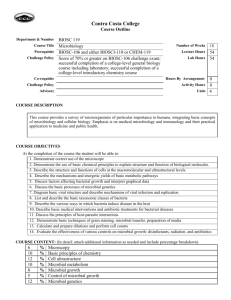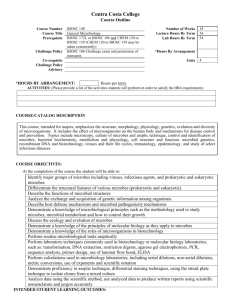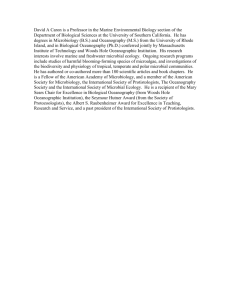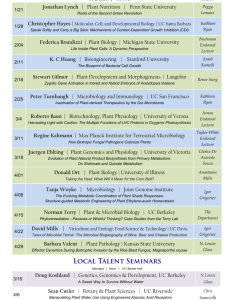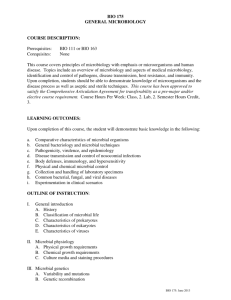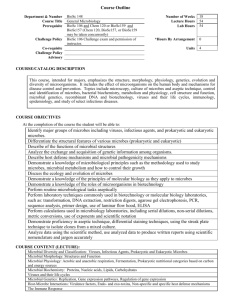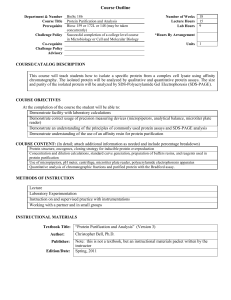BIOSC 119-F14 96KB Dec 17 2014 11:08:30 AM
advertisement
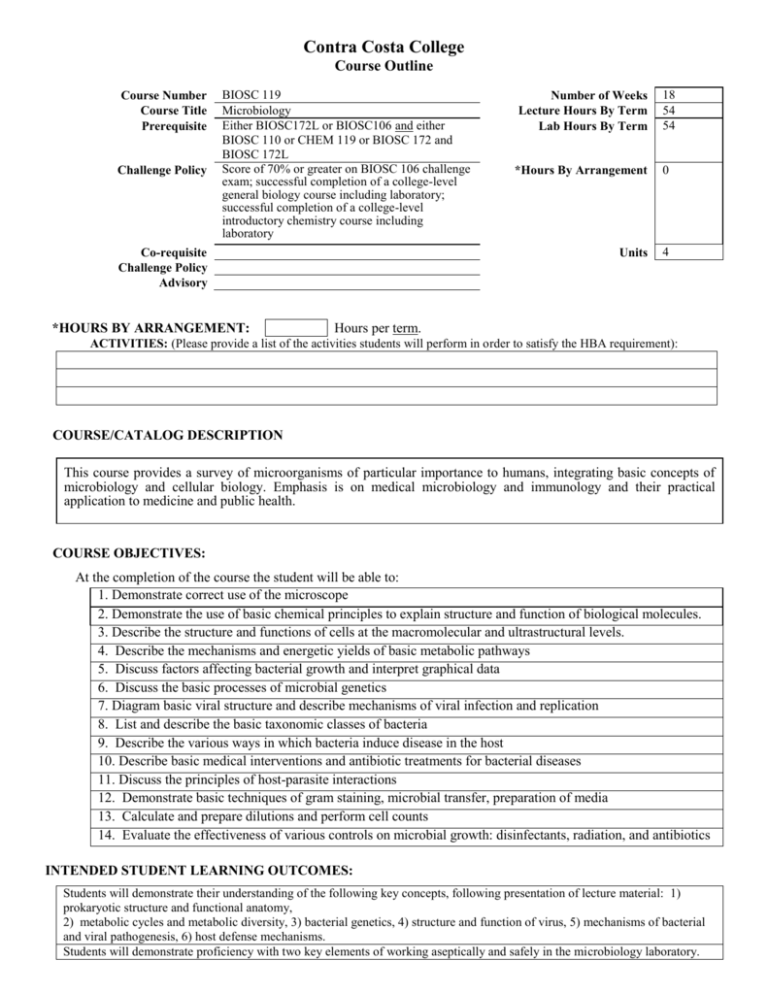
Contra Costa College Course Outline Course Number Course Title Prerequisite Challenge Policy BIOSC 119 Microbiology Either BIOSC172L or BIOSC106 and either BIOSC 110 or CHEM 119 or BIOSC 172 and BIOSC 172L Score of 70% or greater on BIOSC 106 challenge exam; successful completion of a college-level general biology course including laboratory; successful completion of a college-level introductory chemistry course including laboratory Co-requisite Challenge Policy Advisory *HOURS BY ARRANGEMENT: Number of Weeks Lecture Hours By Term Lab Hours By Term 18 54 54 *Hours By Arrangement 0 Units 4 Hours per term. ACTIVITIES: (Please provide a list of the activities students will perform in order to satisfy the HBA requirement): COURSE/CATALOG DESCRIPTION This course provides a survey of microorganisms of particular importance to humans, integrating basic concepts of microbiology and cellular biology. Emphasis is on medical microbiology and immunology and their practical application to medicine and public health. COURSE OBJECTIVES: At the completion of the course the student will be able to: 1. Demonstrate correct use of the microscope 2. Demonstrate the use of basic chemical principles to explain structure and function of biological molecules. 3. Describe the structure and functions of cells at the macromolecular and ultrastructural levels. 4. Describe the mechanisms and energetic yields of basic metabolic pathways 5. Discuss factors affecting bacterial growth and interpret graphical data 6. Discuss the basic processes of microbial genetics 7. Diagram basic viral structure and describe mechanisms of viral infection and replication 8. List and describe the basic taxonomic classes of bacteria 9. Describe the various ways in which bacteria induce disease in the host 10. Describe basic medical interventions and antibiotic treatments for bacterial diseases 11. Discuss the principles of host-parasite interactions 12. Demonstrate basic techniques of gram staining, microbial transfer, preparation of media 13. Calculate and prepare dilutions and perform cell counts 14. Evaluate the effectiveness of various controls on microbial growth: disinfectants, radiation, and antibiotics INTENDED STUDENT LEARNING OUTCOMES: Students will demonstrate their understanding of the following key concepts, following presentation of lecture material: 1) prokaryotic structure and functional anatomy, 2) metabolic cycles and metabolic diversity, 3) bacterial genetics, 4) structure and function of virus, 5) mechanisms of bacterial and viral pathogenesis, 6) host defense mechanisms. Students will demonstrate proficiency with two key elements of working aseptically and safely in the microbiology laboratory. Students will demonstrate proficiency with and mastery of oil-immersion microscopy COURSE CONTENT (Lecture): Microscopy Basic principles of chemistry Cell ultrastructure Microbial metabolism Microbial growth Control of microbial growth Microbial genetics Antimicrobial chemotherapy Viruses Classification and taxonomy of microorganisms Prokaryotes Principles of disease Microbial pathogenicity Host-parasite relationships COURSE CONTENT (Lab): Microscopy Cell ultrastructure Microbial metabolism Microbial growth Control of microbial growth Antimicrobial chemotherapy Viruses Classification and taxonomy of microorganisms Prokaryotes Host-parasite relationships METHODS OF INSTRUCTION: Lecture: Formal presentations of major concepts and methodologies in microbiology, supplemented with current journal information, and discussion of medical topics relevant to allied health sciences. Laboratory experimentation: Exercises in basic microbiological laboratory procedures and techniques including isolation and identification of bacteria, Gram staining, calculations and preparation of dilutions, control of bacterial growth, enzyme-linked immunosorbent assay, and scientific writing. INSTRUCTIONAL MATERIALS: NOTE: To be UC/CSU transferable, the text must be dated within the last 7 years OR a statement of justification for a text beyond the last 7 years must be included. Textbook Title: Author: Publisher: Edition/Date: Textbook Reading Level: Justification Statement: Lab Manual Title Author: Publisher: Edition/Date: Microbiology: An Introduction Tortora, G., B. Funke, C. Case Benjamin Cummings 11th, 2011 12-14 n/a Experiments in Microbiology Levine, K., Dixon, D. Contra Costa College Bookstore 2014 OUTSIDE OF CLASS WEEKLY ASSIGNMENTS: Title 5, section 55002.5 establishes that a range of 48-54 hours of lecture, study, or lab work is required for one unit of credit. For each hour of lecture, students should be required to spend an additional two hours of study outside of class to earn one unit of credit. Title 5, section 55002(a) 2F establishes coursework should call “for critical thinking and the understanding and application of concepts determined by the curriculum committee to be at college level.” For degree applicable courses: List one example of critical thinking out-of-class assignments Outside of Class Weekly Assignments Hours per week Weekly Reading Assignments (Include detailed assignment below, if applicable) 2 Read chapter 3 in the textbook in preparation for this week’s lecture and lab. Weekly Writing Assignments (Include detailed assignment below, if applicable) 2 BioSc 119 Short Paper #2 - Morbidity and Mortality Weekly Report (MMWR) The Centers for Disease Control and Prevention (CDC), based in Atlanta, GA, collects data on a number of nationally notifiable diseases - those that require health care providers to report cases to their county or state public health authority. This week in lecture, we learned about Incidence - the number of new cases of a disease per unit population per period of time - and Prevalence - the number of new and existing cases of a disease over a period of time. For this short paper, you are going to use the information from the CDC's Morbidity and Mortality Weekly Report (available at cdc.gov) to analyze the incidence and prevalence of one of the nationally notifiable diseases assigned by your professor, over the course of a year - July 1, 2013, to June 30, 2014. Once you’ve collected that data, then go to the US Census Bureau’s website (www.census.gov), and look up what the total population of the United States was as of Jan 1, 2014. You will use this data to calculate the annual incidence in cases per 100,000 population. Your report should contain the following: 1) Incidence data for your disease for the 52-week period; 2) A graph of your incidence data for that 52 week period; 3) A graph showing the number of *cumulative* cases which occurred over the year by week; 4) A paragraph discussing any trends, such as seasonality, or apparent epidemics, associated with your disease (for a bit of extra credit, dig a bit deeper, and note any regional or age related trends); 5) And a paragraph discussing the basic characteristics of your disease, including its etiology and pathology. Weekly Math Problems (Include detailed assignment below, if applicable) Lab or Software Application Assignments (Include detailed assignment below, if applicable) Other Performance Assignments (Include detailed assignment below, if applicable) 2 Prepare a laboratory report according to standard scientific format. Use lecture and lab manual material in the introduction section. You may briefly summarize lab procedures. Data from lab 3 should be presented accurately and figures should be well-labeled. Do not interpret data in the data section. In the analysis and conclusions section, explain how the data you observed relates to appropriate general concepts of microbiology, and explain what the data tells you about the bacteria you are studying. STUDENT EVALUATION: (Show percentage breakdown for evaluation instruments) Title 5, section 55002 (a) 2A requires that the grade be based on demonstrated proficiency in subject matter. For degree applicable courses: Course requires essay writing, or, in courses where the curriculum committee deems appropriate, problem solving exercises, or skills demonstrations by students. Title 5, section 55002(a) 2F requires that coursework call for critical thinking and the understanding and application of concepts determined by the curriculum committee to be at college level. For degree applicable courses: List (an) example(s) of methods of evaluation that assess critical thinking. 20 % Essay Lecture homework and lab reports. Computation or Non-computational Problem Solving Skills 20 % Skills Demonstration 50 % Laboratory practical exams Objective Examinations 10 % % % % Lecture exams, lecture and lab quizzes Other (describe) Laboratory technique demonstrations GRADING POLICY: (Choose LG, P/NP, or SC) Pass / No Pass X Letter Grade 90% - 100% = A 80% - 89% = B 70% - 79% = C 60% - 69% = D Below 60% = F 70% and above = Pass Below 70% = No Pass Prepared by: Katherine Krolikowski, Ph.D. Date: November 2014 Revised form 08/14 Student Choice 90% - 100% = A 80% - 89% = B 70% - 79% = C 60% - 69% = D Below 60% = F or 70% and above = Pass Below 70% = No Pass
